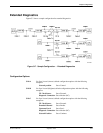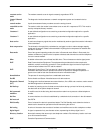
Glossary
Glossary-33910-A2-GN32-40 September 1998
The modem transmits a carrier signal constantly, regardless of RTS.
The diagnostic interface between a network management system and a network device.
It polls downstream tributary modems across the analog channel.
The mode in which the modem’s transmitter turns on and off in response to RTS. This mode is
used by multipoint tributary modems.
A user-defined configuration area containing customized configuration options for a specific
application.
A user-defined configuration area containing customized configuration options for a specific
application.
A continuous frequency signal that can be modulated by another signal that contains information
to be transmitted.
The elimination of empty fields, redundancies, and gaps in order to reduce storage capacity
needs and the amount of data to be transmitted. Anything that is compressed is restored after
the data is received.
One of two general operating modes; the other is Command mode. When in Data mode, the
modem considers any input from the computer to be data and transmits it across the telephone
line to the remote modem.
A decibel referenced to one milliwatt into 600 ohms. This unit measures relative signal power.
Data Communications Equipment. The equipment that provides the functions required to
establish, maintain, and end a connection. It also provides the signal conversion required for
communication between the DTE and the network.
Diagnostic Control Panel. The front panel of a device that continuously provides status
information about the device’s operation and allows an operator to manage its operation. A
generic term used for both the standalone and carrier-mounted models.
The process of recovering data from a modulated carrier wave.
Device Health and Status. A detailed account of device alarms.
The diagnostic interface between two network devices, like a DSU and a modem, used to extend
the NMS diagnostics to downstream devices.
A method of restoring service for data communications during a private line failure by switching
the data traffic to the public telephone network.
A modifier used in the dial string that instructs the modem how to process a dialed telephone
number.
A communications circuit that is established by a switched circuit connection in the dial network.
See PSTN.
One of a leased-line device’s operational states. The Dial Standby mode allows the device to
switch back to leased-line operation while still maintaining the dial line.
A series of characters that consists of numbers and modifiers used to dial a telephone number.
A signal composed of only two discrete values, representing the binary digits 0 and 1.
Nonvolatile memory that stores up to ten telephone numbers. Each directory location can have
up to 40 characters entered.
Canadian Department of Communication.
constant carrier
mode
Control Channel
(CC)
control modem
controlled carrier
mode
Customer 1
Customer 2
data carrier
data compression
Data mode
dBm
DCE
DCP
demodulation
DevHS
Diagnostic Channel
(DC)
dial backup
dial command
modifiers
dial line
dial network
Dial Standby
dial string
digital signal
directory location
DOC


















